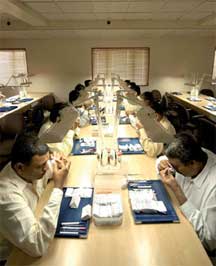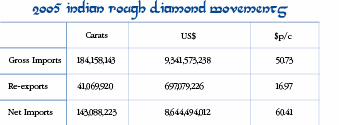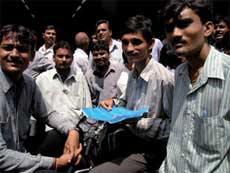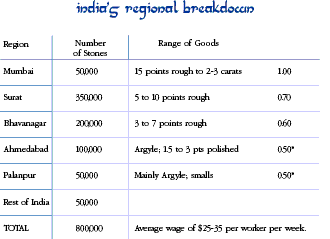Defining the Seasons
September 02, 06
 |
The diamond trade is centered in, controlled, and monitored from Mumbai. There are many factories cutting better qualities in Mumbai, but high overhead and real estate prices have triggered a move to suburbs such as Borivli, Kandivli, Malad, and Goregaon.
The smallest sizes are being processed in Bhavanagar. The typical rough reaching the city runs from 3 to 7 points, resulting in polished of 0.5 to 2 points. Labor costs here are at most $0.60 per stone. Ahmedabad is a relatively new diamond-processing center. This area was traditionally known for its textile industries. When textiles moved to even cheaper labor cost areas, the vacuum was filled by the diamond industry. The workers there specialize in Argyle goods.
Research conducted in 2001 estimated that of the (then) one million workers 65 percent worked in the informal sector. There are other estimates suggesting that it is far more. McKinsey consultants found that 70 percent of the entire non-agricultural labor force in India operates in the informal (“black”) sector and stress that in labor-intensive industries with relatively small capital investments, which applies to the diamond sector, the informal market is probably much higher. We believe this to be the case and it may well be a sustainable situation, as the industry has developed efficient and even sophisticated systems to move diamonds processed in the informal sector to the formal economy for export purposes.
| |
*Production costs on Argyle goods are 20 percent higher because of the use of diamond-impregnated scaifes. The processing costs have come down lately because of the present recession.
Analysts have attempted to divide the industry into three categories:
- Large-sized organized units, professionally managed and employing over 250 workers. These units are typically owned by exporters.
- Medium-sized organized units, employing between 100 and 250 workers, who are primary contractors with links to exporters. These two groups are believed to represent some 25 percent-30 percent of all manufacturers.
- Semi-organized units (a euphemism for informal market) that generally employ fewer than 100 workers. They lack professional management and consist of secondary contractors or tertiary contractors.
Characteristic informal market manufacturers operate partially or wholly outside the law by underreporting unemployment, avoiding taxes, and failing to adhere to social or minimal wage conditions. Productivity is generally lower than in the formal sector. Governments frequently consider it a social or cultural phenomenon; quietly condoning these activities as, they might argue, there is considerable job creation – especially for unskilled workers – and relief of tensions associated with unemployment and poverty in urban areas.
The Indian informal “cottage industry” has its roots in the agricultural sector. Farmers basically had only two and a half “busy months,” during the harvest season. The rest of the year the workload was considerably less. That is when a few diamond wheels were added to the farm – and the diamond cottage industry started to flourish. Farmers in
Understanding the nature of this cottage industry is also relevant for the academic discussion of “child labor”. Child labor is often associated with ruthless exploitation of children in textile sweatshops, etc. Not in diamonds and not in
There are academics – and also major Indian diamond trading house principals – who are convinced, that with the growth of the formal sector, the informal economy will disappear over time. Recent research by McKinsey, specifically on the Indian informal markets, “found these beliefs to be untrue. Rather than getting smaller, the informal economy is growing in many countries.” McKinsey Global Institute (MGI) found that the substantial cost advantage informal companies' gain by avoiding taxes and regulations more than offsets their low productivity and small scale. Competition is therefore distorted because inefficient informal players stay in business and prevent more productive, formal companies from gaining market share.”
The lower costs of informal market operations will make it incredibly difficult for diamond manufacturers in the Far East to ever compete effectively with
Unwittingly, governments are occasionally advancing the formal sector. McKinsey notes that in
A manufacturer in
Unions
Labor unions (especially in Mumbai) create their share of difficulties. It is hard to dismiss workers, and manufacturers often resort to initiating shorter workdays. The structure of the labor force must also be appreciated. There are about 40 large companies that control the lion’s share of the industry. The smaller independent manufacturers have become de-facto subsidiaries of the larger firms. A corollary to this trend is that Indian manufacturers today feel a greater obligation to
provide steady employment than in the past. 
On the Factory Floor
The diamond industry’s labor is geographically spread in different areas and in each of these locations specific ranges of goods are being processed. Moreover, the wages paid in each geographic area may differ substantially. The differential labor costs are striking. The $7-10 per carat labor costs in Mumbai is primarily applicable to the better qualities, averaging 5 points per stone (polished). In the main cutting city of
Rough ranging from 5-10 points now yields polished goods from 1 to 3 points. Yield from the rough ranges from less than 20 percent up to 30 percent, and the industry-wide average yield is 21 percent. Some 15 stones in these ranges can be cut for just $10! Cutting smaller goods is labor intensive and when the material value is less than the labor value, the industry is less vulnerable to the impact of rough price fluctuations, in comparison to the traditional centers.
Whenever low labor costs are discussed, it should be noted that, in general, the wages paid in the Indian diamond industry are about 10-15 percent higher than the earnings for non-skilled labor in other industrial sectors. Factories adopt either a straight salary system or base the wages on piece-work. There is no set rule. The piece-rate system tends to generate higher income for the workers than the minimum legal wages (about $12 for a 45-hour working week for unskilled workers), while the diamonds wages are considerably higher; the labor force works 55 hours for $25-35 per week).
Manufacturers estimate that workers can produce four stones per day for an average of 10 points per day polished. In most centers, workers work six days a week (except for
This anecdotal evidence, based on interviews, is vindicated by the figures. We have calculated that each worker polishes 36 carat per year. If the average worker spends nine months a year in a factory, then a worker produces 4 carats per month. As the average size of a locally processed polished stone is about 0.01 carats, a worker polishes some 200 stones per month (about 10 points polished per day). At production costs of about $0.60/stone, a worker can earn between $5-7 per day. (The first $1,000 per year is tax free, and above that, workers pay 35 percent tax plus 3 percent social security.)
Out of the Monsoon
Diamond statistics in

The jump in rough import prices does not lend itself for easy interpretation. Only two years earlier, in 2003, the per-carat values of gross imports and re-exports were considerably lower (at $37.18 per carat imports; $8.99 re-exports). In recent years, polished diamond exports have been overstated in order to become eligible for import duty credits and other financial benefits tied to increased export proceeds of 25 percent or more per year. When export figures are inflated, probably also to secure more bank financing tied to overseas shipments, the rough diamond import values are adjusted accordingly, to avoid gross incongruities in the reported margins for tax and accounting purposes.
Though Indian industry leaders publicly take pride in their sector’s healthy debt-equity ratio, the opaque nature of the business has recently given rise to concern among international bankers. They have almost no knowledge on the informal banking credit levels. Nevertheless, it is beyond any doubt that the Indian diamond industry has in the past three decades accumulated greater capital than any other cutting center. Until a few years ago, profits on diamond exports were fully tax exempt. There had never been a reason not to repatriate earnings. The Indian industry shows more equity on its books than any other diamond center. It may well be that over 70-75 percent of the worldwide diamond industry’s equity is in Indian hands.
Tax on Export Profits
Until a few years ago, all profits made by exporting companies were fully tax exempt. Responding to public pressure, the government decided to impose taxes on exporting companies as well. A gradually increasing tax was imposed over a period of five years;
- 7 percent in the first year
- 10 percent in the second year
- 21 percent in the third year
- 28 percent in the fourth year
- 35 percent for the fifth year and thereafter.
It is interesting to see what kind of profits an industry reports to the tax authorities after having been tax exempt. Informed sources say the books of diamond exporting companies show average profits of about 4 percent on turnover. This makes the final taxation equivalent to, or even somewhat lower, than the de-facto taxation in
Financing Terms 
Banks involved in the Indian diamond industry include the State Bank of India, ABN/AMRO Bank, Bank of Baroda, and about 70 smaller banks. The domestic banking indebtedness to the diamond industry is estimated at approximately $3.5-$4 billion. To this one must attribute about half of the
By mid-2006, there were some 70 banks active in diamond industry financing providing around $3.5-$4 billion in credit.
The Reserve Bank of
The diamond business has access to ‘packing facilities’ (to finance the production process) and ‘post shipment finance’ (to finance the export credits extended to the overseas customers). About 30-40 percent of the Mumbai financing is for packing credit; the remaining 60-70 percent is for export financing. The financing is mostly in rupees and, according to a leading banker, “about 15 percent of total financing is extended in foreign currency at LIBOR (London Interbank Offered Rate) plus 1 percent interest (bank lenders are not allowed to charge more than this amount on export credits).”
Indian diamantaires have traditionally proven to be very astute in utilizing exchange rate fluctuations and, when devaluations were expected, foreign currency is acquired in advance and export proceeds repatriated later. However, the recent stability of the rupee has made these considerations less prominent.
Informally Speaking
Our own research has followed the tremendous rise of the informal banking system in the Indian diamond sector through the Angadias. The informal market manufacturers find it difficult to obtain formal credits, often their companies may not even be a legal entity, they have no balance sheets, etc. With anywhere between 600,000-800,000 diamond workers “employed” in the informal market, rather sophisticated (sophisticated in their simplicity) informal financing systems have emerged.
An Angadia, (literally, a carrier, one who carries on his person) is an old courier system, which has very efficiently functioned between the principal cities of
Angadias also act as an informal banking system. Virtually all Indian diamond traders and manufacturers have accounts with Angadias, often in several different names.
- Angadias will deliver diamonds and collect the cash;
- Angadias will keep the cash for you on your behalf;
- Angadias will transfer from your account to those of others diamond dealers held with the same Angadia or with another;
- Angadias are basically doing exactly what Hawala systems do;
- Angadias will provide credit at terms above the banking rate;
- Angadias will also allow lenders to earn interest;
- Angadias will also serve as traditional Hawala in the banking aspect.
 |
The informality of the Indian diamond market is both its strength and its attraction. The degree of trust among the players ascends the traditional “mazal u’bracha” handshake - the trust is the basic fabric that keeps an industry with almost a million players together. Outsiders (and that includes De Beers) barely understand the intricacies of the Indian market. They have always been confounded by the Indian industry’s ability to work in unison. Many years ago, when the losses on the DTC Sight boxes were too high to justify, they collectively decided not to take a Sight – and recruited the government to issue an “import stop” on rough. It worked. (When, many years earlier, a similar decision was made in
Officially, Indian diamantaires will downplay the importance of the informal market - and for good reason. Though informality thrives because of weak enforcement and government lacks adequate audit capacity, there are “penalties” when caught. It is the stated policy of the government to move the informal sectors into the formal economy - but the diamond industry is not a major priority and, in practice, this is a slow process, one sector at a time. In diamonds, the informal sector has facilitated the sustained rise of a sector that accounts for almost a fifth of all Indian exports. No government is in a hurry to upset such industry. Moreover, when other economic sectors move into the formal sphere, and the middle class grows, the domestic demand for diamond jewelry is expected to accelerate. The Indian Government has embarked on a strategy of export-led growth. It is committed to dismantling red tape, liberalizing foreign investments, reducing tariffs and ending state monopolies.
